How to get 12 volts
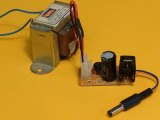 To check the operation of individual blocks of household appliances, a home handyman may need 12 volts, both DC and AC. We will analyze both cases in detail, but first it is necessary to consider another amount of electricity - power, which characterizes the ability of the device to reliably perform work.
To check the operation of individual blocks of household appliances, a home handyman may need 12 volts, both DC and AC. We will analyze both cases in detail, but first it is necessary to consider another amount of electricity - power, which characterizes the ability of the device to reliably perform work.
If the power of the source is not enough, then it will not do the job. For example, a computer power supply and a 12 volt car battery. Computer load currents rarely exceed 20 amps, and car battery starting currents are more than 200 A.
A car battery has a large reserve of power for computer tasks, but powering a computer with the same voltage of 12 volts is absolutely not suitable for starting a starter, it will simply burn out.
Methods of obtaining constant voltage
From galvanic cells (batteries)
The industry produces round batteries of various sizes (depending on the power) with a voltage of 1.5 volts. If you take 8 pieces, then when connected in series, you will get only 12 volts.
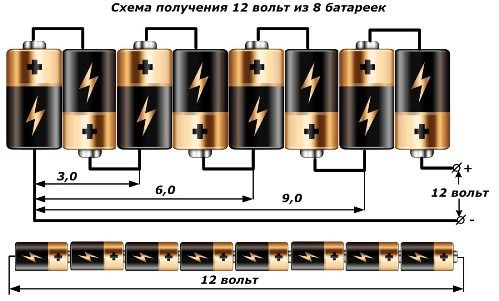
It is necessary to connect the terminals of the batteries one by one with the «plus» of the previous one to the «minus» of the next one. A voltage of 12 volts will be between the first and last terminals, and intermediate values, for example, 3, 6 or 9 volts, can be measured on two, four, six batteries.
The capacity of the cells should not differ, otherwise the power of the circuit will be reduced by a weakened battery. For such devices, it is desirable to use all elements of the same type of series with a common date of manufacture. The load current from all 8 batteries connected in series corresponds to the value indicated for one cell.
If it becomes necessary to connect such a battery to a load twice the nominal value of the source, it will be necessary to create another similar structure and connect both batteries in parallel by connecting their unipolar terminals together: «+» to «+», and «-» to «-«.
From small size batteries
Nickel-cadmium batteries are available in 1.2 volts. To get 12 volts from them, you will need 10 elements to be connected in series, as described above in the circuit.

By the same principle, the battery is assembled from nickel-metal hydride batteries.
The rechargeable battery is used for longer operation than conventional galvanic cells: the battery can be recharged and charged repeatedly if necessary.
From AC power supplies
Many household appliances have built-in electronics that are powered by a rectified voltage as a result of the conversion to 220 volts. Computer, laptop power supplies just give 12 volts rectified and stabilized voltage.
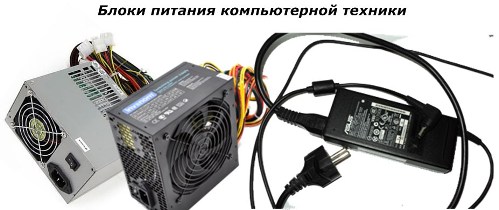
It is enough to connect to the corresponding terminals of the output connector and supply power to get 12 volts from it.
Similarly, you can use the power supplies of old radios, tape recorders and outdated televisions.
Alternatively, you can assemble a DC power supply yourself by choosing a suitable circuit for it. Most often transformer devicesconversion of 220 volts into a secondary voltage, which is rectified by a diode bridge, smoothed by a capacitor and regulated by a transistor using a trimming resistor.
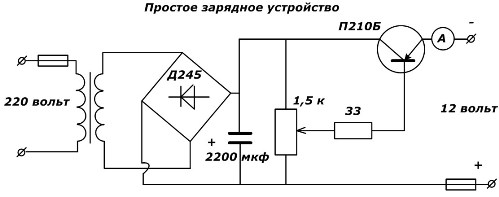
Simple diagram of a charger
You can find many similar schemes. It is convenient to include stabilizing devices in them.
Ways to obtain alternating voltage
Using a transformer
The most affordable method is considered to be the use of a step-down transformer, which is already shown in the previous diagram. The industry has long produced such devices for various purposes.
However, it is not at all difficult for the home craftsman to make a transformer for his needs from old structures.
To connect the transformer to the 220 network, the primary winding must be powered by protection, it is quite possible to cope with a proven fuse, although a circuit breaker is more suitable for these purposes.
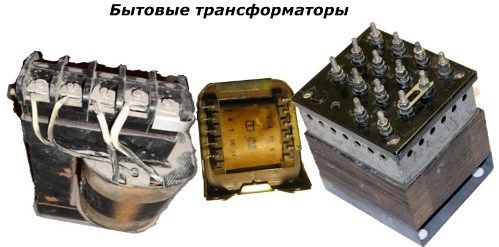
The entire secondary load circuit must be pre-assembled and tested. The power reserve of the transformer of about 30% will allow it to work for a long time without overheating the insulation.
Other methods
It is technically possible to get 12 volts AC from a generator that is driven by some kind of motor or by converting DC to an inverter. However, these methods are more suitable for industrial installations and have a complex design.Therefore, they are practically not used in everyday life.
